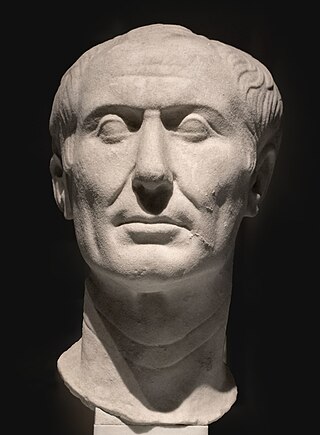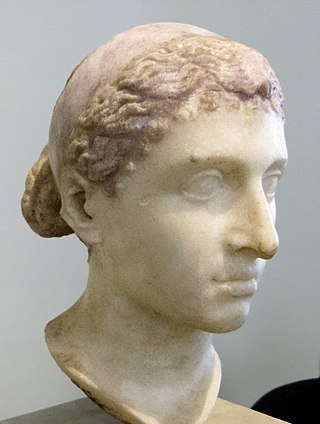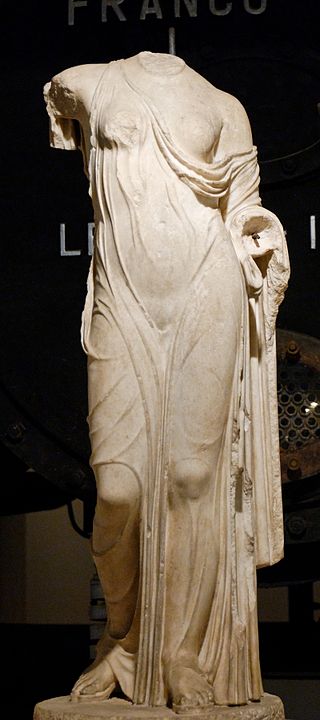
Gaius Julius Caesar, was a Roman general and statesman. A member of the First Triumvirate, Caesar led the Roman armies in the Gallic Wars before defeating his political rival Pompey in a civil war, and subsequently became dictator from 49 BC until his assassination in 44 BC. He played a critical role in the events that led to the demise of the Roman Republic and the rise of the Roman Empire.

Year 244 (CCXLIV) was a leap year starting on Monday of the Julian calendar. At the time, it was known as the Year of the Consulship of Armenius and Aemilianus. The denomination 244 for this year has been used since the early medieval period, when the Anno Domini calendar era became the prevalent method in Europe for naming years.

Cleopatra VII Philopator was Queen of the Ptolemaic Kingdom of Egypt from 51 to 30 BC, and its last active ruler. A member of the Ptolemaic dynasty, she was a descendant of its founder Ptolemy I Soter, a Macedonian Greek general and companion of Alexander the Great. After the death of Cleopatra, Egypt became a province of the Roman Empire, marking the end of the last Hellenistic state in the Mediterranean and of the age that had lasted since the reign of Alexander. Although her first language was Koine Greek, she was the only Ptolemaic ruler to learn and use the Egyptian language.

Arles is a coastal city and commune in the South of France, a subprefecture in the Bouches-du-Rhône department of the Provence-Alpes-Côte d'Azur region, in the former province of Provence.

The Vatican Museums are the public museums of the Vatican City. They display works from the immense collection amassed by the Catholic Church and the papacy throughout the centuries, including several of the most well-known Roman sculptures and most important masterpieces of Renaissance art in the world. The museums contain roughly 70,000 works, of which 20,000 are on display, and currently employ 640 people who work in 40 different administrative, scholarly, and restoration departments.

Roman currency for most of Roman history consisted of gold, silver, bronze, orichalcum and copper coinage. From its introduction to the Republic, during the third century BC, well into Imperial times, Roman currency saw many changes in form, denomination, and composition. A persistent feature was the inflationary debasement and replacement of coins over the centuries. Notable examples of this followed the reforms of Diocletian. This trend continued into Byzantine times.

Atia was the niece of Julius Caesar, and mother of Gaius Octavius, who became the Emperor Augustus. Through her daughter Octavia, she was also the great-grandmother of Germanicus and his brother, emperor Claudius.

The study of Roman sculpture is complicated by its relation to Greek sculpture. Many examples of even the most famous Greek sculptures, such as the Apollo Belvedere and Barberini Faun, are known only from Roman Imperial or Hellenistic "copies". At one time, this imitation was taken by art historians as indicating a narrowness of the Roman artistic imagination, but, in the late 20th century, Roman art began to be reevaluated on its own terms: some impressions of the nature of Greek sculpture may in fact be based on Roman artistry.

Gaius Julius Caesar, one of the most influential men in world history, has frequently appeared in literary and artistic works since ancient times.

Caesar Augustus, also known as Octavian, was the first and among the most important of the Roman Emperors. As such, he has frequently been depicted in literature and art since ancient times.

The Venus Genetrix is a sculptural type which shows the Roman goddess Venus in her aspect of Genetrix, as she was honoured by the Julio-Claudian dynasty of Rome, which claimed her as their ancestor. Contemporary references identify the sculptor as a Greek named Arcesilaus. The statue was set up in Julius Caesar's new forum, probably as the cult statue in the cella of his temple of Venus Genetrix. Through this historical chance, a Roman designation is applied to an iconological type of Aphrodite that originated among the Greeks.

The Arles bust is a life-sized marble bust of a man, possibly Julius Caesar, dating to around the 1st century BC. It is part of the collection of the Musée de l'Arles antique.

The Eleven Caesars was a series of eleven painted half-length portraits of Roman emperors made by Titian in 1536-40 for Federico II, Duke of Mantua. They were among his best-known works, inspired by the Lives of the Caesars by Suetonius. Titian's paintings were originally housed in a new room inside the Palazzo Ducale di Mantova. Bernardino Campi added a twelfth portrait in 1562.

Hubert Goltz or Goltzius was a Renaissance painter, engraver, and printer from the Southern Netherlands. He is not to be confused with the much more famous Hendrik Goltzius, who was his cousin, once removed.

The Archaeological Museum of Thasos is a museum located in Limenas on the island of Thasos, Eastern Macedonia, Greece. It occupies a house that was built in 1934 and recently extended. Storerooms and workshops have already been organised, and nowadays is fully operational: the shop, the official functions room, the old wing, the prehistoric collection, and the new section.

The Green Caesar is a portrait of Gaius Julius Caesar made of green slate kept in the Antikensammlung Berlin, which was probably made in the first century AD.

The Tusculum portrait, also called the Tusculum bust, is the only extant portrait of Julius Caesar which may have been made during his lifetime. It is also one of the two accepted portraits of Caesar which were made before the beginning of the Roman Empire. Being one of the copies of the bronze original, the bust has been dated to 50–40 BC and is housed in the permanent collection of the Museum of Antiquities in Turin, Italy. Made of fine-grained marble, the bust measures 33 cm in height.

Julius Caesar is the name of a bust by 16th century artist Andrea Ferrucci depicting Roman dictator Julius Caesar. The sculpture is a Chiaramonti-Pisa type style bust of Caesar inspired by the Chiaramonti Caesar portrait.

Roman Republican art is the artistic production that took place in Roman territory during the period of the Republic, conventionally from 509 BC to 27 BC.

The Ides of March coin, also known as the Denarius of Brutus or the EID MAR, is a rare version of the denarius coin issued by Marcus Junius Brutus from 43 to 42 BC. The coin was struck to celebrate the March 15, 44 BC, assassination of Julius Caesar. It features a bust of Brutus, who was one of the assassins, on the obverse while the reverse features a pileus cap between two daggers. The coin was minted in both silver and gold. Approximately 100 of the silver coins are known to exist, but only three of the gold examples have survived. The coin is considered one of the rarest ancient Roman coins.




















